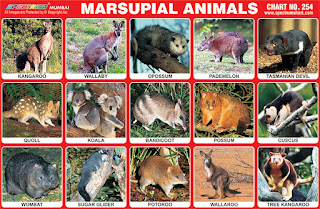Kangaroo - Kangaroos are
marsupial animals that are found in Australia as well as New Guinea.
They have a deep pouch on their front in which they carry their
young ones. Red kangaroo is the largest marsupial in the world.
Kangaroos are herbivores. They eat grass, shrubs, shoots and tree
leaves. Their lifespan is 4 to 10 years.
Wallaby - Wallaby is a
small- or mid-sized macropod found in Australia and New Guinea. They
belong to the same taxonomic family as kangaroos. Wallabies are
herbivores whose diet consists of a wide range of grasses,
vegetables, leaves & other foliage.
Opossum - Opossums are
medium sized animals with pouch. They are the only marsupials that
live in North America and Canada. Opossums prefer woodlands near
streams, rivers, marshes. Their body is covered with white-greyish
fur. Opossums have more teeth than other mammals i.e. 50. They are
omnivore.
Pademelon - Pademelon is
small marsupial and close relative of wallaby and kangaroo. There
are 7 species of pademelon that can be found in Australia &
Papua New Guinea. It inhabits wet sclerophyll forests and
rainforests in the coastal areas. Pademelon is covered with soft fur
that is dark brown to grey-brown on the back and reddish-brown or
creamy-coloured on the belly. Pademelon has pointed nose, round,
dark-coloured eyes, prominent, erect ears, stocky body, short legs
and short, thick tail.
Tasmanian Devil - Tasmanian
devil is the largest marsupial carnivore. It can be found only on
the island of Tasmania (Australia). They prefer coastal scrublands
and forests. Body of Tasmanian devil is covered with black fur, with
white patches on the chest, shoulders and rump. Tasmanian devil has
large head and very strong jaw. Tasmanian devil is a carnivore.
Quoll - Quoll belongs to
the group of carnivorous marsupials. Quoll inhabits forests,
scrublands and grasslands. Quoll is covered with coarse coat that
can be grey, brown or black in colour. Basic colour of the fur is
enriched with prominent white spots. Quoll has pointed snout and
pink nose. Its powerful jaw is equipped with sharp teeth. Tail is
long and bushy. Quolls live in the underground burrows.
Koala - Koalas are native
to Australia and live in eucalyptus forests. They have poor
eyesight, but excellent sense of smell, which helps them find type
of eucalyptus they like to eat. Koalas spend most of their time in
trees. They sleep 16-18 hours per day. They are nocturnal animals.
Bandicoot - Bandicoot is a
small marsupials. Bandicoot can be found in the rainforests, wet and
dry woodlands, swamps and thickets of Australia. Bandicoots have
long, pointed snout, large ears, short body and long tail. Their
body is covered with fur that can be brown, black, golden, white or
grey in colour. Bandicoots are omnivores.
Possum - Possum is any of
about 70 small to medium sized arboreal marsupial species native to
Australia, New Guinea and Sulawesi. Possums tend to be found
inhabiting bush-lands and rainforests where the possums live in
hollow trees and logs. The possum lives a predominantly arboreal
lifestyle. They are nocturnal animals.
Cuscus - Cuscus is a medium
size marsupial that lives in Australia & Papua New Guinea. They
inhabit in tropical rainforests, mangroves and dense forests at high
altitudes (3900 feet). Cuscus is covered with thick, wooly fur that
can be black, brown, white, tan or grey in colour. Fur can be covered
with spots. Cuscus has rounded head with small ears and large, round
eyes. Eyes can be orange, red or yellow. They are designed for night
vision.
Wombat - Wombat is an
animal that belongs to group of marsupials. It can be found in
southeastern coastal regions of Australia. Wombats prefer wet and
forested areas on the slopes, open grasslands and eucalyptus
forests. Wombat's body is covered with fur that can be ochre, dark
brown or black in colour. Wombats dig underground burrows that can
be 100 feet long. Wombats are herbivores. Their diet consists mainly
of grass, roots, shrubs, moss and bark.
Sugar Glider - Sugar glider
is tiny marsupial. It can be found in Australia, Tasmania, Indonesia
and Papua New Guinea. Name "sugar glider" originates from
the fact that this animal likes to eat sugar and that it can glide
through the air. Sugar glider has large eyes that provide excellent
night vision as it is nocturnal animal. Sugar glider is an omnivore.
Potoroo – A potoroo is a
kangaroo-like marsupial about the size of a rabbit. All three extant
species are threatened, especially the long-footed potoroo
(Endangered) and Gilbert's potoroo (Critically Endangered). The main
threats are predation by introduced species like foxes and habitat
loss.
Wallaroo – A wallaroo is
an Australian macropod with its size between the big kangaroos and
the small wallabies. The name "wallaroo" is a mix of
wallaby and kangaroo. Most wallaroos are smaller than a kangaroo and
live in open, rocky country. They have particular habit of stance,
wrists raised, elbows close into the body and shoulders back, and
all have a large black nose.
Tree Kangaroo - There are
14 species of tree kangaroos that can be found in Australia,
Indonesia and Papua New Guinea. Tree kangaroo inhabits lowland
rainforests and cloud forest on the altitude of 11,000 feet. Tree
kangaroo has reddish-brown coat with light-coloured bands on the
back. It has pale-coloured belly, whitish-yellow face and reddish
ears and feet. Tree kangaroo spends its life on the trees. Diet of
tree kangaroo consists of leaves, flowers, shoots, bark, eggs and
small birds.


No comments:
Post a Comment